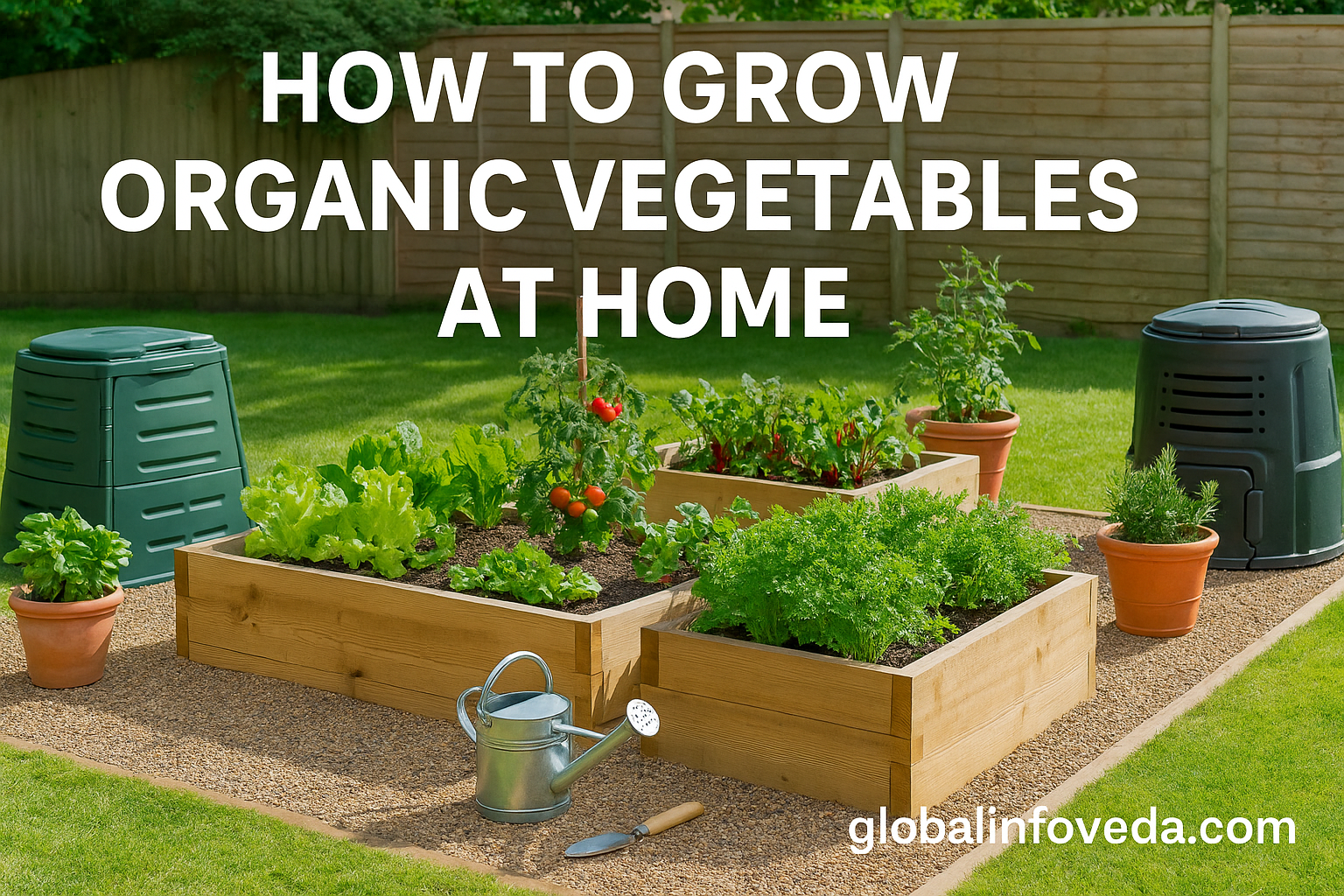Grow Organic Vegetables at Home
Growing organic vegetables at home is a fulfilling, sustainable, and cost-effective way to improve your health and reduce your ecological footprint. Whether you have a backyard, balcony, terrace, or even a sunny windowsill, you can grow fresh, pesticide-free veggies with just a little time, planning, and dedication. This comprehensive step-by-step guide covers everything from space planning and seed selection to pest control and harvesting—ensuring your home garden thrives naturally and sustainably.
🌿 Step 1: Choose the Right Location
A successful garden starts with the right spot.
- Sunlight: Choose a space that receives 4–8 hours of sunlight daily. South or west-facing spaces are ideal for maximum exposure.
- Airflow: Ensure adequate airflow to reduce humidity buildup and prevent fungal growth.
- Accessibility: A location close to your kitchen makes it easier to maintain and harvest regularly.
- Tip: Use wall-mounted planters, hanging baskets, and vertical stands to maximize small spaces.
🌱 Step 2: Pick Your Vegetables Wisely
Start with vegetables suited to your space, climate, and experience level.
- Short-term crops (20–40 days): Lettuce, spinach, mustard greens, radish
- Long-term crops (60+ days): Tomatoes, brinjal, chilies, gourds
- Multi-harvest crops: Methi, coriander, mint—regrow after each harvest
- Companion planting options: Pair basil with tomatoes, or marigolds with cucumbers for natural pest defense
- Seasonal planning: Grow cool-season veggies (e.g., broccoli, peas) in winter and heat-tolerant plants (e.g., okra, amaranth) in summer
🧂 Step 3: Prepare Organic Soil Mix
Soil health directly affects plant health.
- Basic Mix Ratio (1:1:1):
- 1 part sterilized garden soil
- 1 part well-decomposed compost (kitchen waste, cow dung, or vermicompost)
- 1 part cocopeat/sand for aeration and water retention
- Enhancers:
- Neem cake powder to deter soil pests
- Bone meal and wood ash for phosphorus and potassium
- Trichoderma or mycorrhizal fungi for disease resistance and root health
🌼 Step 4: Choose Containers or Garden Beds
Adapt to available space and plant types.
- Container Size Guide:
- Herbs: 6–8 inch pots
- Leafy greens: 8–10 inch pots
- Fruiting plants: 12–18 inch deep containers
- Materials: Clay pots (breathable), plastic (lightweight), wooden crates (recycled)
- Drainage: Place broken tiles or stones at the base before adding soil to improve drainage
🌾 Step 5: Sowing the Seeds
Your garden begins with a seed!
- Germination Tips:
- Use seed-starting trays indoors for delicate plants
- Maintain warmth and moisture during germination
- Depth Rule: Sow seeds at a depth of 2–3 times their diameter
- Spacing Rule: Avoid overcrowding; poor spacing leads to competition and disease
- Transplanting: Harden seedlings by exposing them to outdoor conditions gradually before replanting
💧 Step 6: Watering Wisely
The right watering technique prevents plant stress.
- Morning Routine: Water early in the day to allow foliage to dry and prevent fungal infections
- Soil Check: Water only when the top 1 inch of soil feels dry
- Drip Irrigation: Use slow drip systems or perforated bottles for consistent moisture without waste
- Avoid Splashing: Water at the base of the plant to avoid leaf rot
🌞 Step 7: Provide Sunlight and Structural Support
Help your plants grow straight and strong.
- Full Sun vs Partial Shade: Fruiting plants need full sun, leafy greens thrive in partial shade
- DIY Supports: Use recycled bamboo sticks, jute rope, or mesh wire for climbers
- Netting: Use garden nets to protect from birds and excessive sun
🐛 Step 8: Natural Pest Control (The Organic Way)
Build plant resilience with safe, natural solutions.
- Neem Oil Spray: Antifungal and insect repellent—apply every 7–10 days
- Homemade Sprays:
- Chili-garlic-tobacco infusion
- Onion-mint spray
- Beneficial Allies: Attract bees, butterflies, and predatory insects like ladybugs
- Integrated Pest Management (IPM): Combine physical removal, plant spacing, and trap crops (e.g., mustard to attract aphids)
🍃 Step 9: Organic Fertilization & Nourishment
Feed the soil and microbes to ensure a thriving ecosystem.
- Weekly Boosters:
- Banana peel tea for potassium
- Epsom salt for magnesium (use sparingly)
- Cow dung slurry for nitrogen
- Monthly Boosters:
- Jeevamrut or Panchagavya (fermented organic tonic)
- Bioenzymes for soil conditioning
- Mulching Benefits: Retains moisture, suppresses weeds, and adds organic matter
🧺 Step 10: Harvesting the Right Way
Timely harvesting maximizes taste and promotes regrowth.
- Signs of Ripeness:
- Leafy greens: Harvest when 4–6 inches tall
- Tomatoes: Fully colored but still firm
- Gourds: Young and tender for best flavor
- Harvest Tools: Use sharp scissors or pruning shears to avoid plant damage
- Staggered Harvests: Pick in phases to extend yield throughout the season
🌻 Bonus Tips for Success
- Soil Rotation: Shift crops between pots to prevent nutrient depletion
- Observation: Watch plant behavior—drooping, yellowing, or wilting signals underlying issues
- Composting Tip: Use a covered bin with layers of greens (veggie peels) and browns (dry leaves, cardboard)
- Record Keeping: Track varieties, yields, and problems in a gardening diary or app
👨👩👧👦 Get the Whole Family Involved
Turn gardening into a shared activity.
- Build a bird bath or butterfly feeder to engage children with nature
- Let kids decorate pots and name plants
- Create a shared harvest calendar for the whole family to follow
💚 Why Organic Gardening Matters
- Health: No synthetic chemicals or GMOs
- Economy: Saves grocery bills and boosts self-sufficiency
- Community: Share excess harvest with neighbors or participate in local seed exchanges
- Well-being: Gardening reduces stress and boosts mood
🌐 Discover more eco-living tips, organic recipes, and urban gardening hacks at GlobalInfoVeda.com
